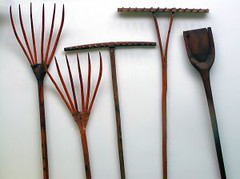 Gardening tools vary from manual to mechanical equipments, depending on the type of gardening activity needed. Applying a landscape to a simple garden makes the whole yard attractive and a nice place to spend time with friends and family members. Although hiring a landscaper is a good idea, creating a personalized do-it-yourself landscape at home is more therapeutic and resource-saver. Some of the basic landscaping tools needed include shears, shovel, lawnmower, wheelbarrow, ratchet pruners, string trimmers, and sprinklers.
Gardening tools vary from manual to mechanical equipments, depending on the type of gardening activity needed. Applying a landscape to a simple garden makes the whole yard attractive and a nice place to spend time with friends and family members. Although hiring a landscaper is a good idea, creating a personalized do-it-yourself landscape at home is more therapeutic and resource-saver. Some of the basic landscaping tools needed include shears, shovel, lawnmower, wheelbarrow, ratchet pruners, string trimmers, and sprinklers.
Shears are needed to tame and control overpowering and twisted shrubbery so they could be made into designs that will complement the whole landscape. The shovel on the other hand, being the most basic tool, is used for digging soils to plant trees, shrubs, and flowers. In some contexts, the lawnmower doesn’t come as a basic gardening tool; however, for big gardens, this equipment is needed to level off and maintain the height of the grass. The wheelbarrow is simply needed to transport soil, seedlings, and other gardening tools from one place to another so it saves time and motion.
Pruners are an essential tool to snip trees to control their uncontainable growth so the garden doesn’t look like a messy hoax-forest. Ratchet pruners are specifically designed for this purpose. The trimmer string is basically used for all trimming needs around the house and the garden. This tool comes very handy in the garden. Finally, although not considered as a tool, a sprinkler is certainly one of the basic needs in the garden. It generally waters the whole landscape and backyard so the plants are healthy and well-irrigated.
Follow us on Social Media!